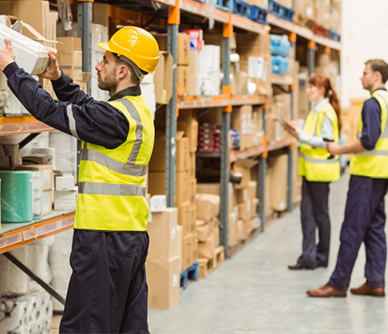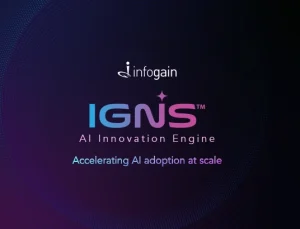- Posted on : December 4, 2020
-
- Industry : Retail
- Type: News

This is an authored article by Utsah Khianra, Associate Vice President, Travel & Retail at Infogain, that appeared in Logistics Insider. To read the original article, please click here.
E-commerce has transformed retail in an exceptional manner, influencing consumers’ expectations to find the desired products both in-store and online and purchase them with the swipe of a finger. As the advent of e-commerce brought global competition from players such as Amazon, warehouses started emphasizing omnichannel capabilities.
According to a survey by the MHI Annual Industry Report, as many as 80% of the respondents believe that digitalization that includes an intelligent, efficient, and automated warehouse has the power to disrupt the storage and warehousing industry. To support long-term growth, even membership-based warehouse clubs are striving globally for a balance between in-store operations and e-commerce.
The warehousing sector in India started as nondescript four-walled ‘godowns,’ but it has rapidly evolved into technologically equipped spaces capable of handling modern-day storage requirements. The Warehouse Automation Market in India 2020 report demonstrated that the evolution and application of advanced technologies in India like AI, Industrial Internet of Things (IIoT) and Blockchain, are impelling warehouse operators to adopt automated systems.
Let’s take a closer look at the technologies behind transforming the storage and warehousing industry:
Embracing cloud-based systems
A cloud-based warehouse management system (WMS) is a must in today’s industry. These systems leverage the industry standard ‘software as a service (SaaS)’ or ‘platform as a service (PaaS)’ that can seamlessly integrate with other enterprise systems and sustain without any downtime.
The storage and warehousing industry can leverage these systems to create new processes to work directly in the cloud, ensure better customer experiences. WMS systems are considered to be the backbone of the storage and warehousing industry; getting the right system for your operations can not only double your shipping efficiency with 100% accuracy but also make directed put aways a smooth and efficient process. Infogain works with several product providers to modernize their product suites and help them integrate their products at their end clients.
Smart Analytics and Machine Learning
To increase customer satisfaction, warehouse managers are increasingly relying on predictive analytics and AI, leveraging statistical techniques such as predictive modeling, big data, and data mining for recommending optimized inventory levels, replenishing inventory, and increasing operational efficiency as well as warehouse optimization.
Walmart-owned Flipkart leverages big data and analytics for warehouse management and deploys machine learning to match their product assortment to meet evolving consumer demand.
There is still immense potential for AI adoption in India: a survey conducted by Data Pulse revealed that only 38% of the organizations in India had implemented AI in their supply chain and logistics operations. Infogain’s teams have been at the forefront of the adoption of Data Analytics and AI, working with many enterprises across the globe to help our clients understand the key performance indicators for warehouse management.
Embrace e-commerce—your way
Big time retailers across the globe have been placing a greater emphasis on e-commerce and omnichannel capabilities, including developing same-day and two-day grocery delivery, rolling out buy online pick up in-store (BOPIS) services, and opening e-commerce fulfillment centers.
Placing emphasis on fast delivery and keeping the inventory moving has put a lot of pressure on the storage and warehousing industry. Most Indian retailers are reshaping their strategies to compete with Amazon in India and internationally. In the international market, Costco is not only investing heavily to bolster their online presence but also focusing on enhancing fulfillment capabilities with its acquisition of a logistics company from Sears’ for $1 billion.
Integrating new services like logistics has its challenges and is a time consuming process. The key is to keep the business running and ensure smooth integration. Infogain’senterprise software and platform engineering services enable enterprises to drive their digital agenda. We do it through customer engagement platforms, line-of-business applications vital to delivering customer services and solutions, and internal enterprise applications for driving operational efficiency.
Hyperautomation
According to a leading analyst firm, by 2024, organizations will lower operational costs by upto 30% by combining hyperautomation technologies with redesigned operational processes.
While enterprises embarking on RPA journeys showed initial signs of success, automation programs at some point reached a saturation level. The key reason for this was enterprises lacked a strategy to scale automation. Automation was seen as a tool to achieve short-term wins rather than as an end-to-end automation approach.
With the storage and warehousing industry, today labor is a significant expense. Optimizing labor utilization and inventory control procedures helps companies reduce their rates and remain competitive with international players. For these companies, hyperautomation is a viable option and should already have started.
According to TechSci Research report on forecast and opportunities for India’s Warehousing Market by 2025, the industry is projected to grow to $19.5 billion on account of the ongoing modernization and advancements in warehouses. With better infrastructure through efficient use of technology and workforce and initiatives like “Make in India,” the warehousing industry is bound to play a larger role in the growth of the Indian economy.

This article has been authored by Utsah Khianra. He is an AVP for the Retail and Travel segments at Infogain, a Silicon Valley headquartered company with software platform engineering and deep domain expertise across industries.





